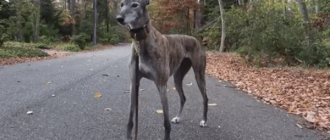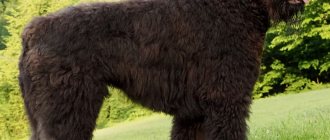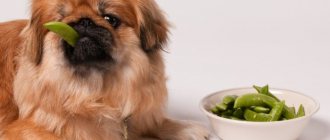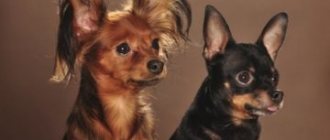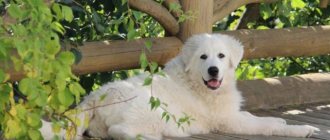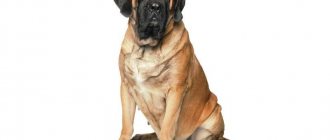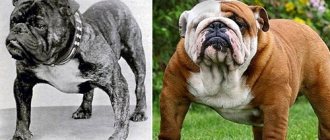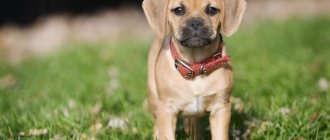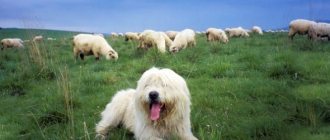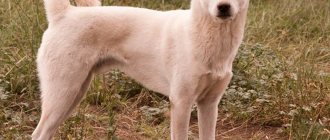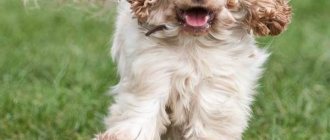Just don’t forget that this family member requires increased attention and acquiring one is a big responsibility.
Brief history of origin
The English Great Dane is one of the oldest dog breeds. She evokes admiration and respect just by looking at her. The breed is also called the Great Dane. The ancestors of these giants are considered to be Tibetan dogs, common in ancient times.
Mastiff-like dogs were brought to England by Celtic tribes back in the 3rd century BC. They were used in military operations by Alexander the Great. One animal was equivalent to two foot soldiers.
The ancestors of the English Great Dane served as slave overseers and participated in large game hunting.
The early ancestors of the English Great Dane, with their enormous size and impressive weight, had a ferocious and extremely aggressive disposition. In England they were used to entertain the nobility with a bloody, cruel spectacle. The participants in the massacre were chained wild animals and an enraged giant mastiff.
After the ban on animal fighting in 1835, huge dogs gradually began to disappear. Almost 40 years later, the breed was revived. In 1872, enthusiastic dog breeders created a club to restore the Old English Mastiff.
The following breeds were used:
- Saint Bernard;
- Alpine Mastiff;
- Great Dane.
At the exhibition in 1873, the first of the new mastiffs, or English Great Danes, appeared. A dog named Tauras became the progenitor of all modern varieties of this breed.
During the Second World War, the Great Dane was once again in danger of extinction. Outside of England, and even in the country itself, individuals of the Great Dane could be counted on one hand. But thanks to skillful selection, this problem was solved quite quickly.
Already in the 60s of the 20th century, the breed was not only restored, but also significantly improved. Since then, the majestic, self-conscious Great Danes have been gaining popularity.
Origin and purpose
Actually, as everyone knows, “Dog” translated from English is a dog. That is, if you think logically, there are no other dogs except Great Danes. Quite a royal approach. But even among those breeds that bear this proud name, there is an aristocratic hierarchy. And the Royal Dane among them is the coolest and most important.
According to the main version, this breed originates from Molossian dogs, which were bred back in the days of Ancient Rome. According to some reports, they were then used to track down and persecute runaway slaves. In the dark Middle Ages, the ancestors of today's dogs enthusiastically hunted wild boars, poisoned bulls with them, and they also acted as bodyguards.
Times have changed. Along with them, the character of these dogs and their modern name changed. Now the Royal Dane is better known as the Great Dane.
Interesting Facts
- Special dog armor was made for the huge English mastiffs that took part in military battles.
- Jewelry craftsmen from Alexandria have come up with an interesting method of cutting precious stones. An expensive item was wrapped in a large piece of meat and given to the mastiff to eat along with large bones. In the stomach of the animal, the bones were so polished that the jewelers had to do practically nothing else. A slave was assigned to the animal, who was called a “henchman.” He had to extract a valuable element from the droppings. The precious stone, having been in the animal’s stomach, had a special shine and smoothness.
- Great Danes helped Roman fishermen catch bulls. For this, the dog was trained to perform a special trick. The mastiff entered the water not far from the shore and waited for the water to calm down. Then he sharply lowered his muzzle into the depths and, exhaling air, gurgled loudly. The fish floated up from under the stones, and the dog began to jump and hit the water with its powerful paws. Stunned by the blows, the bulls became quick prey for cunning fishermen.
Dietary recommendations
In the first six months of life, frequent meals in small portions are necessary. Then you can smoothly switch to three feedings a day.
Throughout your life, you need to fortify your diet with calcium to minimize the risks associated with fragility of long bones.
In accordance with age, the diet should also change - from an emphasis on fats and slow carbohydrates in childhood, towards protein foods in adulthood. This is necessary so that the growth of muscle mass does not outpace the growth of bones and thereby cause their deformation.
Preference should be given to natural, easy-to-digest foods due to a weak stomach.
Diseases
Despite the short life expectancy, the dog matures late - by 16-24 months. During this entire period, the bones are susceptible to injury, so the pet should be protected from falls and jumping from high obstacles.
The special structure of the stomach creates the risk of bloat. After meals, you need to limit your dog's physical activity. The immune system is relatively weak, and people often catch colds in winter. The problem can be partially solved by timely vaccination.
If your dog is not feeling well, you should not self-medicate. Regular examinations by a veterinarian will save your dog from premature death due to undetected pathologies.
- Neapolitan Mastiff - features of the breed and a detailed description of the dog. Character, properties and characteristics inherent in the breed (145 photos)
- Doberman: description of the breed and character. Tips for training and feeding habits of dogs (95 photos)
- South Russian Shepherd - cost and description of the breed. Characteristics of dogs and their maintenance (105 photos and videos)
Breed description, standards and appearance
The English Great Dane is the largest representative of the canine genus. Rarely distributed in our country. Therefore, not everyone knows what a real Great Dane looks like.
This is a very large dog with regular, proportional shapes. English Dane girls are more elegant, graceful and light, as befits a true “lady”. Their height at the withers reaches 69–72 cm with a body weight of 68 kg.
Mastiff boys are real heavyweights. With a height of 76 cm they can weigh from 85 to 95 kg.
Interesting to know! The weight of the heaviest English mastiff, Aikama Zorbo from Great Britain, was 155 kg.
The standards for a purebred English Great Dane are as follows:
- The head is square in shape with a flat forehead.
- The muzzle is blunt, short, and makes up a third of the head.
- The lower jaw is wide with a straight pincer-like bite.
- The nose is large, black, with pronounced nostrils.
- The eyes are dark brown, the whites are almost invisible.
- The ears are small, drooping and close to the cheekbones.
- The torso is strong and strong.
- The neck is wide and muscular.
- The tail is set high, thick at the base, narrowed towards the end.
- The paws are strong and powerful.
- Movements are free, the step is wide.
- The back is always straight when moving.
Any deviations from these standards may be cause for disqualification of the Great Dane according to the breed criteria.
Color and coat type
Representatives of the English Dog breed are characterized by short, thick hair that lies tightly to the body. Under the coat, which is hard to the touch, there is a soft, even thicker undercoat.
The main coat colors of Great Danes are:
- silver;
- deer;
- brindle;
- apricot;
- yellowish brown.
The dog's ears should be black, regardless of the main color. The standard feature on the muzzle is a black goggle mask.
Should be considered! Due to their rather short fur, giant dogs get cold quickly. Therefore, it is better to keep a Great Dane indoors. And when going out for a walk in the cold, dress your pet in warm vests and jackets.
physical characteristics
Standard physical characteristics are as follows:
- according to the parameters of the NKC club, the male has a height of 58.4 to 68.6 cm and a weight of 36.3 to 56.7 kg, and the female has 55.9–66 cm and 27.2–47.6 kg, respectively;
- according to the standards of the ABNA union, the male is 56–71 cm and 31.5–54 kg, and the female is 51–66 cm and 27–45 kg.
The large head of the American Bulldog dog looks massive. The top of the skull is flat with a pronounced transition along the forehead-bridge line. There is a deep furrow on the forehead. The muzzle is distinguished by an upturned nose and thick, slightly sagging cheeks. They show black pigmentation.
- The most popular dog names in alphabetical order with recommendations
- Shar Pei - history of the breed, character traits, care and possible problems + 87 photos
- Yorkshire Terrier: history of the breed, features, choice of puppy, maintenance, health (83 photos + video)
The animal's eyes are round in shape, but can be elongated. They are located high. Iris is popular in dark brown tones. The cartilage on medium-sized ears is curved towards the muzzle, and sometimes to the side.
The muscular body is close in shape to a square. The deep chest is characterized by rounded ribs.
The adjacent coat is insignificant in length - up to 2.5 cm. White, fawn and red shades are popular. This can be clearly seen in the photo of the American Bulldog.
Colors
There are a large number of dog coat color options. But for exhibition animals only 5 options are allowed:
- Pure black. There are no spots on the dog's body. Its dark fur has a beautiful natural shine. Small light spots on the neck are acceptable (only in females).
- Golden. Very beautiful coat color. Also shiny. There is short dark hair on the face and ears.
- Brindle. The main body shade is yellow or sand. Multi-colored stripes of different lengths and thicknesses are also visible. There is no shine.
- Black and white. The dominant color is white. Dark spots have different diameters. Most of them are on the face and back.
- Blue. Beautiful light gray color. There are no spots on the dog's body. It has a natural shine.
The Great Dane's fur is very short, and on any part of its body.
Colors
Standard colors include brindle, fawn, black and blue. The latter is in fact gray, and a blue tint appears at a certain incidence of light.
A single color is rare; as a rule, the main color contains inserts and inclusions of other shades.
In photos of Great Danes, the most common color you can see is white with black spots. It remains the most popular.
Character and behavior
The English Great Dane, which looks fierce and vicious, has a calm, gentle character. The kind, slobbering goofball dotes on all members of his family, including pets. However, he treats strangers with caution and suspicion.
The behavior of the English Mastiff can be characterized by the following epithets:
- nobility;
- calm;
- splendor;
- equilibrium;
- courage.
Not a trace remained of the aggressiveness and cruelty of his ancestors. This is the result of the work of skillful breeders who consciously tried to soften the ferocity of the character of the four-legged giant.
The Great Dane is distinguished by equanimity bordering on phlegmaticity. His restraint and endurance can be envied. It takes a lot of work to get a good-natured Great Dane excited. He will not bark over trifles.
The attachment of a Great Dane to its owner is sometimes aggravating in the literal sense of the word. The dog is not indifferent to strong hugs and will not miss the moment to jump onto the lap of its beloved owner. Everything would be fine if it weren’t for the impressive weight of the English Mastiff. Nursing such a “baby” is by no means easy.
The trembling and gentle giant has exemplary guard qualities. The Great Dane will not be the first to attack a stranger, but it will not allow the “enemy” to enter private territory. Having driven the enemy into a “corner”, a reliable watchman will wait for the owner to return.
As befits true aristocrats, the Great Dane loves to lie on the sofa for hours. Sport is not his element. Walking with the owner, the dog walks alongside him decorously and importantly, demonstrating to others his independence and power.
However, the calmness of the grenadier mastiff can disappear if he suddenly becomes interested in something. While running, a Great Dane can reach quite a high speed.
English mastiffs experience loneliness very painfully; they need constant communication. Leaving the giant bored for a long time, the owners risk returning to a destroyed apartment.
Children and English Great Dane
The English four-legged gentleman always has an excellent relationship with children, regardless of age. For the baby he will be a real nanny.
The only negative is that, due to its size, the Great Dane can accidentally knock a child down. Therefore, you should not leave the animal and baby unattended.
For a teenager, a Great Dane will be an excellent companion and reliable protection.
Great Dane training
Great Danes are not aggressive or dominant, but this does not exempt them from training. It must be carried out necessarily, as for any large dog. A poorly behaved giant can cause more problems than an unruly pug. If the owner does not have sufficient knowledge in the field of dog training, it is better to immediately contact a specialist in order to initially develop the correct behavior in the pet.
Great Danes are intelligent and easy to train, but you still have to be patient. Cruelty in handling the pet is completely excluded; the Great Dane can either become cowardly or aggressive. Any of these qualities does not suit him. But these dogs are very sensitive to intonations, therefore, by changing them, you can perfectly convey your attitude to the animal.
You can start training as early as 2 months of age. First, the puppy learns a set of mandatory commands, and this happens quite quickly, as he tries his best to please the owner. After this, more difficult commands can be taught.
Video: how to properly train Great Danes
The success of living together is in education
Let's start with the fact that the Great Dane is a proud animal, so you should beat and scold him only in cases where he is really guilty. Otherwise, the dog may consider you an unfair (read: abnormal) owner and will continue to ignore you as incompetent. A reproachful tone and trust will be more effective, even when the puppy is naughty. At the same time, remember: if you give in and the dog doesn’t recognize you, you won’t get a comfortable existence, there will be a constant quiet war for supremacy.
How to choose the right puppy
It is better to purchase a purebred English Dane puppy from a nursery. Professional breeders advise buying a Great Dane at the age of 1.5 to 3 months.
Babies of this age already have good psychological health and can live without their mother’s care. It is advisable to get to know the parents of small mastiffs and the conditions in which the animals are kept.
The baby dog must have the following external characteristics:
- shiny wool;
- clear lively look;
- wet cold nose;
- strong physique;
- square head;
- powerful paws;
- There are wrinkles on the forehead, but not much.
It is worth paying attention to the character of the baby Great Dane, which is already emerging. If the dog is too timid, this is a sign of an unclean breed.
The best confirmation of the presence of worthy ancestors will be the puppy metrics provided by the nursery. Then it is replaced by a real document – the dog’s pedigree.
It is advisable to familiarize yourself with the relevant documents of the mother and father of the mastiff babies. From them you can find out information about hereditary diseases.
Varieties
There are several varieties of Great Danes, which differ quite greatly in appearance, so the main subtypes should be described in more detail.
German
Representatives of this subtype are among the largest dogs in the world. These pets can reach a height at the withers of up to 92 cm (males), and females - up to 83 cm. These natives from Germany weigh up to 89 kg - boys, girls are a little lighter - about 60 kg.
The standard for this subtype is as follows:
- head – elongated, narrow, proportional to the length of the body;
- neck – larger than average size with well-developed muscles;
- rectangular muzzle with a wide nose and oval eyes;
- high-set ears of medium length;
- The body shape is square, in girls it can be elongated. The short back smoothly transitions into a slightly curved lower back, the wide chest descends almost to the knee joints. The abdomen is usually tucked in;
- the front and hind legs are strong, correctly placed, the paws are dense, rounded;
- smooth, dense wool can have the following colors: black, blue, brindle, fawn, merle.
Caring for puppies
When you decide to place an English Great Dane in your home, you must not forget that a small mastiff is a full-fledged member of the family. He should feel comfortable and cozy in his new place.
The Great Dane puppy is shown a place to rest, play and feed. From the first day, the pet is taught to go to the toilet in a designated tray. Over time, they learn to ask to go outside.
Raising a baby Great Dane is not particularly difficult. Representatives of the breed are smart and easy to train. From the very beginning, you should not allow your pet to jump on sofas and sleep with its owner.
While the Great Dane is still a puppy, it's fun. A soft and warm snuffling lump under your side. But the grown huge dog will simply drive its owner out of bed, and he will have to move into the hallway.
The diet of a growing Great Dane should consist of natural products. The number of feedings depends on the age of the pet:
- up to 4 months – 5 times a day;
- up to 6 months – 4 times;
- up to one year – 3 meals a day.
It is important to know! Great Dane puppies can only be given milk until they are 4 months old. Then it is replaced with fermented milk products.
Breed traits
Breed traits (on a 5-point scale)
| German dog | |||
| Activity | in the house | 2 | |
| on the street | 3.1 | ||
| Obedience | training | 3.6 | |
| strangers | 4.5 | ||
| Domination | in family | 1.8 | |
| over dogs | 2.5 | ||
| Defending your territory | from people | 2.9 | |
| from dogs | 3.4 | ||
| Sociability | in family | 4.9 | |
| with strangers | 3.7 | ||
| with dogs | 3.3 | ||
| Concentration | in family | 1.1 | |
| in front of strangers | 1.9 | ||
| with dogs | 2 | ||
| Aggressiveness | in family | 1.1 | |
| to strangers | 1.8 | ||
| to the dogs | 2 | ||
| to cats | 2.2 | ||
| Family behavior | calmness | 4.4 | |
| demand for affection | 4.7 | ||
| excitability | 3.3 | ||
| playfulness | 3.6 | ||
| excessive barking | 1.7 | ||
| behavioral breakdowns | 1.8 | ||
| Tolerance for children | up to 4 years | 4 | |
| over 4 years old | 4.2 | ||
| Institutional use | watchman | 4.3 | |
| bodyguard | 2.6 | ||
This breed is often compared to the following dog breeds: Doberman (Doberman Pinscher), German Shepherd, Dalmatian, Cane Corso, Longhaired Collie.
The photographs show what Great Danes look like:
Marbled Great Dane
Two Great Danes
Great Dane head
Two marbled Great Danes
Owner reviews
Vera, 39 years old: “I got this faithful and affectionate creature 2 years ago. The most amazing thing is that he seems to understand our speech! I would never have thought that these giants could be so kind and understanding.”
Oleg, 34 years old: “I had a long-lived Great Dane: he lived for 9 years, although the average lifespan for them is about 7. I remember how he joyfully greeted me from work, and as he saw me off, he looked pitifully, almost shedding tears. An exceptionally sensitive dog."
Anna, 23 years old: “A very smart breed and non-aggressive, as many people think. The main thing is to educate correctly, then there will be no problems.”
Advantages and disadvantages
The main advantages of this breed include:
- high intelligence;
- perfectly developed memory;
- smooth short coat that is easy to care for;
- can be a good guard or watchman.
These pets have practically no disadvantages. It may be noted that some individuals may have problems with the gastrointestinal tract - for example, volvulus. Also, these dogs have a short lifespan - about 8 years.
Care and maintenance of an adult dog
You can keep an English Great Dane both in a large mansion and in a city apartment. But subject to regular walking and physical activity.
In order for your pet to feel comfortable, it is necessary to follow some rules for the care and maintenance of such a large family member.
The right diet
Feeding an English Dane is not an easy task. The pet eats quite a lot. Therefore, most owners prefer to feed the English giant dry food.
You need to select exclusively premium food with calcium supplements to eliminate problems with bones and joints that are typical for dogs of powerful breeds.
When compiling a natural menu for an English Dog, it is important to comply with the following requirement: food should not be too high in calories.
A complete diet for a British Great Dane should include:
- varieties of dietary meat;
- eggs;
- low-fat fermented milk products;
- vegetables (exclude potatoes and cabbage);
- offal;
- sea fish fillet;
- porridge (rice, buckwheat).
You cannot feed English Danes food with spices, long bones, river fish, mushrooms, or food from the owner’s table. For an adult mastiff, 2 meals a day are enough. You should not overfeed, so as not to provoke obesity and unwanted complications.
Initially, you should choose the type of feeding: dry food or natural food. A combination of two types of diet is unacceptable. The digestion of a huge mastiff will certainly suffer.
The water in the English Dane's bowl should always be fresh, not boiled. Some owners use bottled products to avoid intestinal infections.
Walking and physical activity
The Great Dane has a homebody personality. However, you definitely need to walk your dog at least 2-3 hours a day, especially if the animal lives in an apartment.
A slow, calm Great Dane is sometimes difficult to engage in active play. But the owner should try, because physical activity is necessary for the health and proper development of the English Dane.
A light jog next to the owner or vigorous walking is quite possible for the British giant.
Important to consider! You should not walk your mastiff for a long time in hot weather. Due to the special brachycephalic structure of the muzzle, the breathing of the English Great Dane is somewhat difficult. In conditions of elevated temperatures, the animal begins to suffocate.
Training and education
Dogs of the English Great Dane breed, despite their calm, peaceful nature, need education and training. Once in a new home, the puppy must immediately understand that he is not the leader here at all.
It is necessary to stop the slightest attempts to display aggression and self-will. This should be done through suggestion, but not through physical punishment.
Affection and tenderness can conquer a stubborn pet. But the English Great Dane must respect the firm hand of the owner. Here you need to find a middle ground.
Training a mastiff is not difficult. The dog needs to be praised more often and its successes reinforced with treats. Then the English Great Dane will be happy to obey and obey. Screaming and hitting a mastiff is absolutely not suitable.
You should spend at least an hour training a grown-up Great Dane. It is necessary to repeat learned commands and add new ones. This needs to be done gradually.
Great Danes are highly intelligent. They quickly begin to understand what is required of them. However, some examples of English Great Danes, sensing weakness, can subsequently manipulate the owner and refuse to carry out certain commands, or begin to behave pitifully.
Not wanting to work, they try to “persuade” the owner to return home as soon as possible. You should not follow the lead of a four-legged lazy person. If the owner is unable to cope with the Great Dane on his own, he should seek advice from professional dog handlers.
Care and hygiene
Thanks to your pet's short coat, caring for him is not particularly difficult. The English Great Dane needs to be brushed once every 2 weeks. During shedding, use a stiff brush with bristles. To make the coat shiny and look healthier, you can use suede or fabric. Then the dog will become even more sleek, smooth and neat.
It is necessary to bathe a Great Dane no more than 3-4 times a year. Use only zoo shampoo during bath procedures. “Human” products can cause allergies, irritation and even excessive hair loss.
It is important! After bathing, you should not allow your English Dane to lie in a draft. Despite its indestructible appearance, the dog catches colds easily.
For English Great Danes there are mandatory hygiene measures:
- Dirt, sweat, fat, and food debris can collect in the folds on a dog's face. Therefore, every day you need to wipe the animal’s face with a soft cloth to prevent infection.
- The pet's ears are cleaned once a week with damp swabs, using a solution of boric acid for a drying effect.
- Eyes should be wiped with chamomile infusion or tea. If there is discharge around the eyes, a visit to the veterinarian is needed.
- Weekly dental brushing is essential to keep your pet healthy. This is done with a special brush or a bandage wrapped around the finger in several layers.
- The claws are periodically shortened with a special pruner for large breeds.
Following simple rules will preserve the health of everyone’s family pet and save the owner from unnecessary expenses at the veterinary clinic.
Vaccinations and susceptibility to disease
The outwardly strong, powerful mastiff can suffer from some serious ailments. The most common ones include:
- Joint diseases (dysplasia and osteochondrosis). The physical activity of a Great Dane puppy is limited until it is one and a half years old so that the joints are fully formed and strengthened.
- Digestive problems (bloating, gastric volvulus, intestinal obstruction). You need to carefully select the diet and not physically burden the animal immediately after eating.
- Heart failure. Thickening of the walls of the heart leads to the fact that the organ is unable to pump blood. The dog's behavior becomes lethargic and apathetic. Sometimes they resort to medicinal treatment of the animal.
- Labored breathing. Due to the natural curvature of the nasal passages, the Great Dane sometimes finds it difficult to breathe. In especially severe cases, surgical intervention is resorted to.
The lifespan of an English Great Dane ranges from 6 to 10 years. And in order for the four-legged giant to spend them in health, the owner needs to vaccinate the animal against all kinds of infections on time:
- plague;
- parvovirus enteritis;
- parainfluenza;
- rabies;
- infectious hepatitis;
- leptospirosis;
- trichophytosis;
- coronavirus.
The first vaccination is given to the English Mastiff at 2 months of age. It is tolerated by dogs quite hard: with fever, general weakness and diarrhea. The second vaccination is carried out 3 weeks later. This time the puppy feels lighter.
At six months they are given a rabies vaccination and a complex vaccine against a group of diseases. If your puppy's teeth change during this period, you should wait it out.
At 12 months - a comprehensive vaccination, which is repeated every year thereafter.
Regular care, proper nutrition, daily walks with physical activity will make the life of your beloved pet happy and fulfilling.
Diseases of Great Danes
Hip dysplasia is the scourge of all large breeds. He did not bypass the Great Danes either. Pathology may appear with age. At first, the dog begins to limp, has difficulty getting up after sleep, and takes care of itself when jumping and running. In the future, the problem may develop into complete immobility. Treatment is medicinal - only in the early stages; if the situation worsens, surgery is required.
Other musculoskeletal diseases are also common in Great Danes:
- arthritis;
- osteomyelitis;
- osteochondrosis;
- bone cancer.
The first visual sign of all these pathologies is slight lameness, in which the animal must be shown to a veterinarian.
Other pathologies characteristic of Great Danes:
- Turning of the eyelid (inward), eversion (outward), narrowing of the eyelids (inability to completely close the eyes) - the pathology is corrected surgically.
- Intestinal or gastric volvulus is one of the most common causes of death in these dogs at any age; after torsion of the digestive tract organs occurs, a dog’s life is measured in hours, during which time it is important to carry out surgical intervention.
Marbled Great Danes often suffer from deafness.
Great Danes do not live long, like all large breeds - only 8-10 years. At 8 years old they are already real old men, and there are not many dogs of this age.
Health and illness
Welsh Corgis are strong, healthy dogs that can live up to 12-14 years with proper care. But there are genetic diseases to which they are prone. This breed is often diagnosed with eye diseases: glaucoma, cataracts, progressive atrophy, and retinal dysplasia. Of course, these conditions are more common in older Corgis, but young Pembrokes and Cardigans are prone to lens luxation, which can lead to partial or complete loss of vision. In most cases, surgery helps.
photo: depositphotos.com
Since Welsh Corgis are prone to obesity, this can lead to organ overload and joint deformation.
Therefore, it is important not to overfeed your dog or give him treats from the table, and also to keep him physically active. Hip dysplasia can lead to loss of mobility in the hind limbs
In the initial stages, they can be treated with medication, but in the later stages, surgery cannot be avoided.
Among skin diseases, Pembrokes and Cardigans are prone to raw eczema. Dogs itch, gnaw out pieces and behave restlessly. The fur around the wounds should be shaved to provide oxygen access and treated with an antiseptic. You also need to make sure that the corgi does not lick the wounds, for which they put a dog collar on their neck.
Due to its massive body and short legs, the Corgi runs the risk of injuring its back, causing problems with intervertebral discs. If analgesic therapy does not produce results within 1-2 weeks, surgical intervention is considered. Dogs should also temporarily limit their physical activity. Damage to the spinal cord can cause degenerative myelopathy, an inability to control the muscles of the hind legs. The disease develops gradually and cannot be treated. Not only older dogs are prone to it, but also young dogs who have been injured. Poor nutrition and excessive exercise only aggravate the situation.
photo: depositphotos.com
Corgis are predisposed to a hereditary disease - von Willeband's disease, in which blood clotting is impaired and bleeding occurs. After injuries and operations, dogs are given antithrombotic therapy. Prolonged stress and tension provoke the development of epilepsy. Cramps occur at night or early in the morning
It is important that the dog’s head is raised at this moment and that there are no sharp objects around. This disease is treated with medication
Narcolepsy or sudden heavy sleep is another hereditary disease of the Welsh Corgi. Antidepressants are used to treat it, but they do not always help. The pet is provided with comfortable conditions by placing it in a closed space, and dangerous situations are prevented during an attack. Kidney stones are common in this breed. If medications do not help eliminate the problem, surgery is performed to remove them.
photo: depositphotos.com
Dental problems are rare in Pembrokes and Cardigans. To prevent the formation of tartar, special toothpastes are used. Already existing plaque must be removed.
As Corgis age, they can develop arthritis. They may also suffer from difficult labor, skin asthenia, hypothyroidism and other diseases. Timely visits to the veterinarian and vaccinations will help avoid unwanted health problems in the future. Vaccinations for this breed are given on schedule and help keep the dog healthy for many years.
Pros and cons of the breed
Those wishing to own an English Great Dane should first learn about the advantages and disadvantages of dogs of this breed. So that in the future, when faced with an extraordinary situation, you don’t have to look for a new owner for your devoted pet.
The positive and negative aspects of the breed are reflected in the table:
| pros | Minuses |
| Calm, peaceful disposition | Is somewhat lazy |
| Rarely barks, but the mastiff is an exemplary guard | Not suitable for active sports activities |
| Can be kept even in a small apartment | Very sad alone |
| Friendly to children and pets (including cats and birds) | Susceptible to serious illnesses |
| An excellent defender, despite his apparent phlegmatic nature | Snores during sleep due to the special structure of the skull |
| Easy to train due to his natural intelligence | May be stubborn |
| Short hair does not require labor-intensive grooming | Heavy salivation |
Educational rules
Like any other breed of dog, the Royal Dane has its own characteristics in education.
The generally accepted rule is not to hit an animal with your hand - if, of course, you want it to love you and not be afraid, not understanding your actions. Hands should remain a symbol of peace, affection and consolation. If you punish with your palm, you risk that a sick dog will bite you when you want to calm it down. Under the same nationwide ban, punishment remains in place of the animal. If it has already hidden itself on its mat, it means it has realized everything. And even a dog should have a “house”.
You need to spank - well, your dog has done something wrong, it happens - do it hard, but only once. Beating is the lot of executioners. Your anger or frustration will have a much stronger effect.
And most importantly: education begins from the moment a puppy appears in your home. Even if he is still a fool, he will check for weaknesses regularly. If you want to have an intelligent creature in your house instead of a domestic bandit, educate him!
Brazilian
The Dogo Brasileiro is better known as the Fila Brasileiro. This is a large representative of the Molosser, reaching 60-75 cm at the withers, and in weight - from 40 to 90 kg. The exact origin of dogs is unknown, but there is information that they were used as hunters, shepherds, watchmen, and chasers of slaves. Today, with proper training and timely socialization, Fila Brasileiros grow into excellent companion dogs and family pets.
In appearance, “Brazilians” are somewhat reminiscent of Dogo Argentinos. They are strong, muscular, massive. Their head is large, but its size is proportional to the body. The muzzle is long. The ears are not set high, long and drooping. The eyes are in the shape of tonsils or triangles. Limbs parallel, straight.
The coat comes in short and medium length. It is dense, hard and shiny. The most common colors are black, white, and brown. Various variations are possible.
By temperament, these dogs are friendly, loyal, courageous, decisive, vigilant, and balanced. They are wary of strangers, tolerant of children.
The average life expectancy is 12-13 years. Prices for puppies start at $400.
Saint Bernard (weight – 80-100 kg, height – 70-90 cm)
The history of this breed originates from the Swiss Alps, full of dangerous mountain passes. It is believed that in the 11th century such dogs not only guarded the monastery of St. Bernard, but also helped the monks in searching for travelers lost in the snow and fog. The name of the monastery gave its name to the breed.
The large size of St. Bernards and their dense thick fur, as well as powerful paws and an excellent sense of smell, helped the dogs find people even under a two-meter layer of snow. Thanks to their keen hearing, these dogs can hear an avalanche approaching. In 1983, research conducted by Americans showed that such a talent allows dogs to distinguish sounds with a frequency of up to 46 kHz, while the human hearing threshold is 20 kHz.
Today, these gentle and sensitive giants are rarely used as rescuers, but they feel great in families, where they quickly become friends with children. The popularity of St. Bernards grew significantly after the Beethoven film series in the 1990s.
How much does a puppy cost?
The average cost of an English mastiff varies from 30,000 to 60,000 rubles. Depends on the purebred of the puppy and the titles of the parents.
The price is influenced by the gender of the dog, compliance with standards and the location of the kennel. A lower price most likely means it does not meet the standard of the English Great Dane breed.
However, you shouldn’t give up purchasing such a puppy right away. If the animal is completely healthy, and standard data is not so important for the future owner, it is worth buying a small English Dane.
Let your pet not become a champion of exhibitions and shows. But for the owner and his family, the dog will definitely be a friendly companion and an ideal friend who will be able to brighten up everyday life with warm, tight hugs!
Character of the English Great Dane
The English Dog's character is bad, much worse than that of the English Bulldog, that's why he's not married - it's a joke. Great Danes
very kind and slobbering hulks, but this kindness extends only to members of the family in which the English Great Dane lives, and to good friends of this family; the English Great Dane will treat everyone else with suspicion and sometimes even hostility.
If you already have pets in your home and you decide to get an English Great Dane puppy
, then you can do this without any fear, he will not have problems with other animals, especially if he grew up with them. At first, the puppy will play with the other inhabitants of the house, and when it grows up, it will become their reliable protection, and even if the neighbor’s cat tries to offend your Vaska, his great friend will immediately come to his aid.
Great Danes have no problems with children either; they quickly find a common language, and it doesn’t matter whether they are adults or very young children, an English Great Dane can become a faithful friend and playmate for a teenager, and a nanny and a comfortable soft bed for a child.
